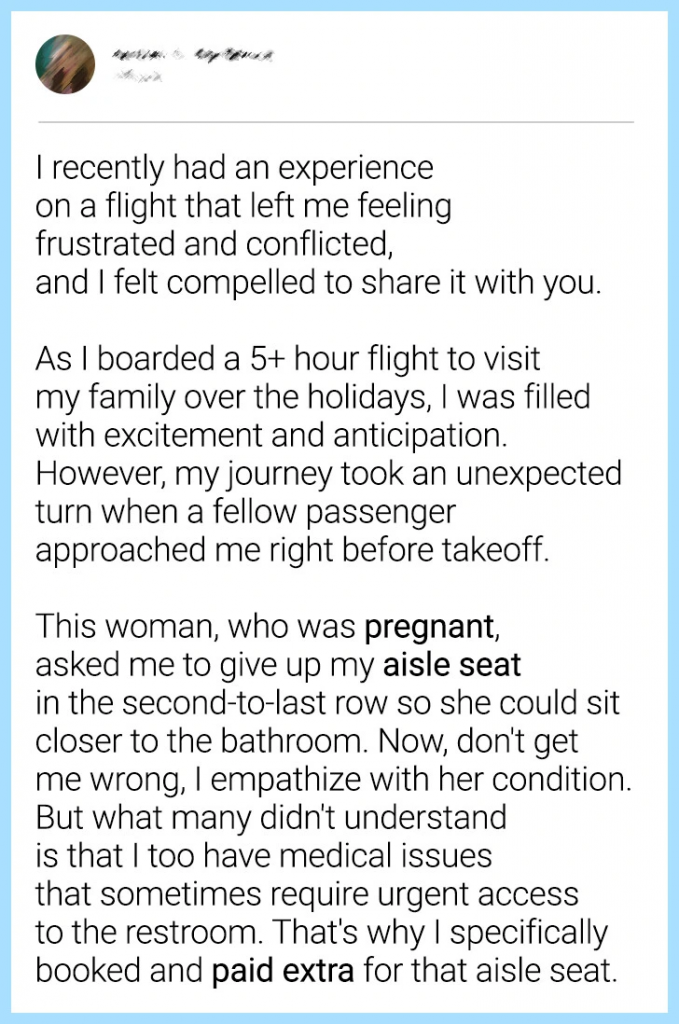Air travel, with its confined spaces and diverse needs, is often a stage for unplanned social interactions and occasionally, uncomfortable conflicts. A recent account from a traveler, “John,” sheds light on one such instance: a pregnant woman requested that he relinquish his seat to accommodate her proximity to the restroom. This seemingly simple ask reveals layers of complexity when we learn John had specifically reserved his seat for medical reasons and had paid extra to secure his spot. His story brings up questions about etiquette, the role of the airline crew, and the delicate balance between individual needs and empathy at 30,000 feet.

When Planning Meets Reality: The Need for Clearer Guidelines
John’s experience exemplifies the importance of planning for any unique travel needs well before takeoff. For him, reserving a seat with specific proximity and comfort was a proactive step to ensure a manageable journey. His decision to pay extra for a particular spot demonstrates how passengers can exercise foresight in addressing their own needs. Yet, when this planning collides with the unexpected, as it did when the pregnant woman requested his seat, it becomes apparent that even thorough preparation doesn’t always guarantee a seamless experience.
Moreover, airlines could potentially ease such situations by offering more transparent options for seat allocation, especially when passengers require special accommodations. Enhanced communication between passengers and flight crews—before the flight takes off—could foster a smoother environment that acknowledges unique needs without placing undue burden on any individual.

Balancing Unwritten Expectations with Practical Boundaries
There is an unspoken code of conduct that most travelers attempt to honor on airplanes. Traditionally, the unspoken hierarchy might dictate that a pregnant woman’s need supersedes a reserved seat. But John’s situation also highlights the limitations of expecting passengers to forgo their own paid arrangements, particularly when medical needs are involved. Here, the ethical expectations of travel etiquette come face-to-face with practical realities: while compassion is essential, should one passenger’s comfort routinely be compromised to accommodate another’s?
This scenario invites an examination of our social responsibilities while traveling. It’s a reminder that each passenger carries individual needs, sometimes unknown to others, and that the decisions we make in these moments can’t be boiled down to simple matters of right and wrong. Instead, it speaks to a balance between respecting personal needs and fostering empathy in shared spaces.

Flight Crew Roles: Should There Be a Standard Approach?
An aspect of John’s story that stands out is the flight attendant’s absence from the negotiation process. Typically, flight attendants are trained to navigate such situations, helping passengers find solutions that best serve everyone’s needs while ensuring onboard harmony. However, in this case, the crew member’s lack of intervention left John and the pregnant woman in a direct conflict, without support or guidance.
This highlights a potential gap in airline training, where clear protocols or gentle mediation could make a difference. In situations where passengers’ personal needs come into conflict, flight attendants could be empowered with strategies to address them in ways that promote understanding while honoring both parties. Well-defined guidelines could help prevent such tensions, allowing crew members to maintain a neutral stance while still aiding in fair compromises.
Understanding John’s Side: When Comfort Is More Than a Preference
John’s perspective is often underrepresented in the common narratives surrounding air travel etiquette. Here, he had gone to lengths to ensure he would be as comfortable as possible on a flight, paying for a particular seat that met his needs. In his view, giving up the seat wasn’t a simple or even reasonable ask, considering his medical condition and his efforts to plan ahead.

This instance reminds us that empathy is a two-way street. John’s perspective offers a counterpoint to the general expectation of yielding to others in need. By sharing his story, he illustrates that we often cannot know what another person might be navigating, physically or emotionally, when they make decisions to prioritize their own well-being.
A Weighing of Needs: Compassion Versus Self-Care
Air travel places unique pressures on individuals, and situations like John’s compel us to look more closely at the weight we place on compassion versus self-care. While most passengers would feel compelled to help a pregnant woman, especially when considering her comfort on a long flight, John’s story provides an opportunity to question whether self-sacrifice is always necessary or even fair. When both individuals’ needs are valid, does the answer lie in deference, or can there be a middle ground?
